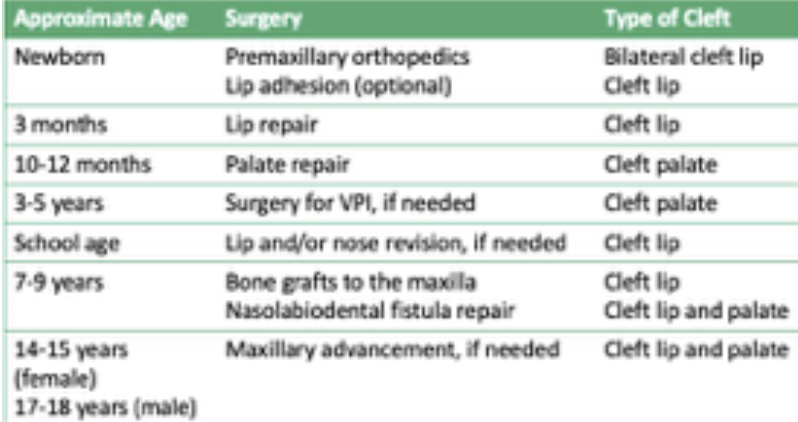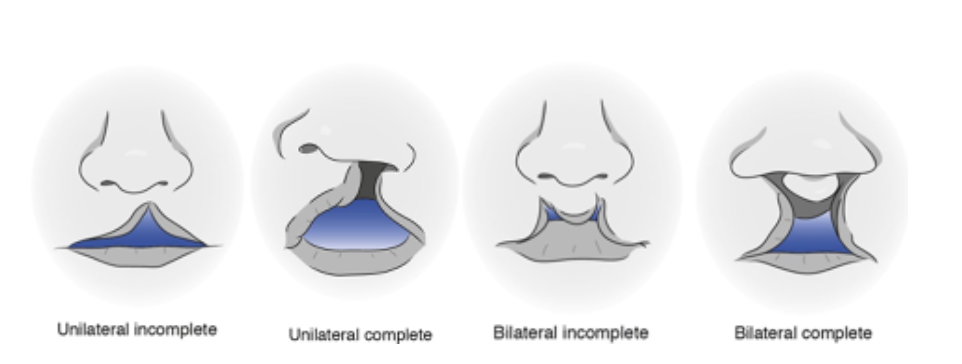CLEFT PALATE IN CHILDREN
What is a cleft?
There are several types of clefts that your child may present. Clefts are caused by the lack of fusion of bones and tissue. Factors may be inherited or environmental. This can also occur on the hard palate (roof) of the mouth or the lips.
Cleft lips are commonly referred to by medical professionals as clefts of the primary palate; this occurs when the lips do not fuse during development. Cleft lips can occur on one side of the mouth (unilateral) or on two sides of the mouth (bilateral). They can be incomplete or complete, meaning that it extends into the nose. Incomplete cleft palates do not extend into the nose.
Cleft palates are commonly referred to as clefts of the secondary palate and occur when there is an opening between the oral and nasal cavity. Incomplete cleft palates occur at the back of the oral cavity and soft palate. Complete cleft palates of the secondary palate extend through the entire roof of the mouth.
If the cleft palate opening connects with the cleft lip opening, the child will have a complete cleft of the primary and secondary palate (both a cleft lip and cleft palate).
What to expect?
Your child will undergo surgeries throughout their developmental years to correct their cleft and resulting differences. The following chart is a general timeline for expected surgeries based on the type of cleft your child has:

Speech-Language Pathologist’s Role:
The SLP will provide counseling for what to expect in regards to your child’s communication development. They will evaluate general development, speech, language, resonance, and velopharyngeal function.
Throughout the process, your child will most likely require feeding, swallowing, and speech therapy. This will be addressed in occupational and speech therapy.
What to expect in Speech Therapy:
Assessment:
The first thing the SLP will do is a comprehensive assessment in order to determine management, monitor progress, and evaluate treatment outcomes. The SLP will begin by asking you questions about your child’s history. They then will assess your child’s speech sounds and resonance.
Following the above observations, the SLP will complete the perceptual evaluation of speech by having your child repeat sentences as well as monitor their speech in conversation. Lastly, the SLP will assess your child’s language and perform any other necessary assessments to determine the need for speech therapy.
Intervention:
The goal of therapy is to focus on the quality of speech and resonance and to achieve normal speech. The SLP will use fun and exciting activities to teach your child the correct placement and way of producing sounds they previously misarticulated. They will also address resonance by teaching the difference between oral and nasal airflow for each sound. This is an exciting time for your child and your family, and practice is key!

Charlotte W. Lewis, Lisa S. Jacob, Christoph U. Lehmann and SECTION ON ORAL HEALTH
Pediatrics April 2017, e20170628; DOI: https://doi.org/10.1542/peds.2017-0628
Rullo R, Di Maggio D, Festa VM, Mazzarella N. Speech assessment in cleft palate patients: a descriptive study. International Journal of Pediatric Otorhinolaryngology. 2009 May;73(5):641-644. DOI: 10.1016/j.ijporl.2008.12.011.

Blog by:
Julianne W. – MS, CF-SLP
(Speech-Language Pathologist)

